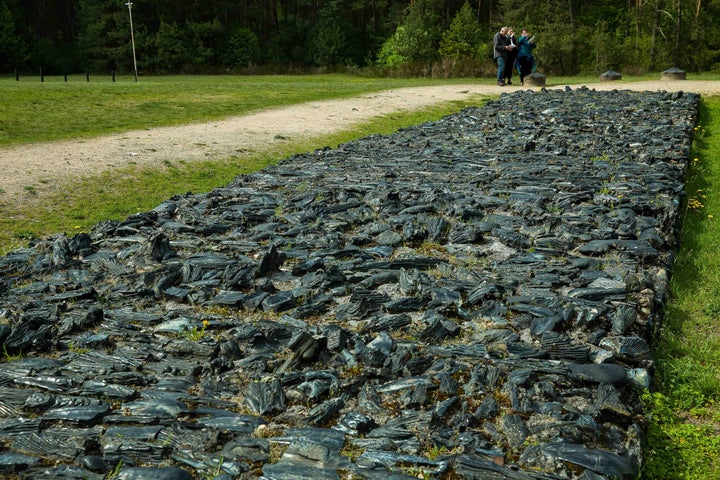Rising anti-Semitism, Holocaust distortion and continued misstatements prove we must transform and expand Holocaust education. A representative of the Conference on Jewish Material Claims Against Germany, Tony Rodriguez, recently traveled to Poland with Paul Salmons, the Programme Director and a team of 13 educators from University College’s Centre for Holocaust Education in London. The impact of their journey is a testament to the need for a Holocaust education program that engages individuals on several different levels, enhancing classroom teachings.
The group’s journey through Poland took them beyond customary stops – locations that do not obviously embody the highly recognizable symbolism of camps, such as Auschwitz, yet still convey the impact of those atrocities and serve as significant expressions of humanity’s capacity for both hatred and resiliency.
The first stop was a Catholic cemetery. They observed well-manicured tombstones with beautiful flowers. A short bus ride later, they parked next to a forest. Tony explained, “We went into a forest and were supposed to identify the significance of the place. The area we were in was thick with trees and with what appeared to be large rocks. At closer glance, we discovered the large rocks were actually tombstones. We were in the heart of a Jewish cemetery. Nature had completely taken over.”
Unlike the Catholic burial ground, the Jewish cemetery was desecrated by the Nazis. But the reason for the lack of upkeep and maintenance was a lack of descendants to care for them after the war. These cemeteries and places like them, are the ongoing scars of the Nazi legacy.
Following the cemeteries, the group traveled through the village of Jadów. Before the Nazi invasion, the population of Jadów was more than 80 percent Jewish. Once the Nazis had occupied the village, the Jews were rounded up; nearly half were shot and the remaining were sent to a concentration camp.
The streets of Jadów were bereft of Jewish families. Very few survived the Holocaust and none had returned. The current residents are mostly descendants of those who watched as their Jewish neighbors were torn from their homes and condemned to their deaths.
As the group walked through the village, people watched from windows. One older woman came outside shouting, “Speak in Polish – we want to hear what you are saying.” Paul explained, on a previous trip another resident had asked, “Have you come to reclaim your property?” Residents were fearful of property owners coming back. For them, the occupants of stolen property, the Holocaust had not yet ended.
On the final leg of the trip, the group retraced the journey imposed on hundreds of thousands of Jews – they traveled to the extermination camp, Treblinka. The Nazis had leveled Treblinka ahead of the allied troop invasion in an effort to obliterate any trace of the activities there. Now, only the testimonies of survivors memorialize the camp.

When Jews arrived at Treblinka, the camp appeared to be an everyday train station, with stretched out tracks, a platform and signs pointing to different cities. But this was an elaborate ruse by the Nazis to keep the masses calm. Arrivals had no idea they were entering a death camp the Nazis called the “Street to Heaven” – which was in fact, a path to the gas chamber.
Devoid of structures, survivor stories are all that is left of the death camp and its gas chambers.
It is imperative that educators have access to these stories, and all of the tools that can make real the lessons of the Holocaust. Site visits for educators can provide context and a deeper understanding to help grasp the enormity of the atrocities perpetrated across Europe. Only by expanding education beyond the classroom can we truly develop educational programming that imparts the weight of unchecked hatred that became the Holocaust.
Reflecting on his trip, Tony felt his visit to the Jewish cemetery in Warsaw was the most impactful. “The smaller tombstones, similar in shape, were used as building material by the Nazis and their collaborators. At one moment, I was walking and suddenly realized someone had created steps out of tombstones. I couldn’t get over it – I still can’t. There were no descendants to take care…no cemetery should look like that. No tombstone should be used as building material, nor anything other than a marker serving as testament to a life and final resting place.”
Not every educator can walk the streets of Jadów, but these trips and experiences are the foundation of what must lead to expanded Holocaust programs. The endeavor toward expanded education is not solely a Jewish issue, but rather a human issue. Survivor stories, educational tours, and other tools that bring the horrific events of the Holocaust to future generations must become part of a more global awareness program.
For many it is a daunting truth – the void in the death camps that were leveled and the absence of residents and their villages represent a chasm left by hatred. Without a revised lens and expanded approach, we risk losing valuable lessons of the past.
